Enfield Grevillea
Enfield GrevilleaGrevillea bedggoodiana | |
|---|---|
| Kingdom: | Plantae |
| Phylum: | Magnoliophyta (Angiosperm) |
| Class: | Magnoliopsida (Dicotyledon) |
| Order: | Proteales |
| Family: | Proteaceae |
| Status | |
| World: | |
| Australia: | Vulnerable (EPBC Act 1999) |
| Victoria: | Endangered (FFG Threatened List 2025) |
| Profiles | |
| Victoria: | |
| Australia: | Species profile and threats database |
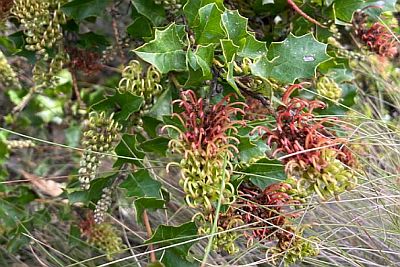
The Enfield Grevillea is a low growing, groundcover shrub endemic to Victoria, only being found in a very limited area around Enfield State Park, south of Ballarat, Victoria.
Enfield Grevillea is one of 39 species of grevillea which are considered threatened in Victoria.
Features
The Enfield Grevillea is a low growing plant from 0.2 to 1 m high and spreads to 3 m wide. It has bright green leaves which tend to stand out against the forest floor. Flowers vary from green to red depending on their stage of development.
For a detailed species discription see Flora of Victoria - Enfield Grevillea.
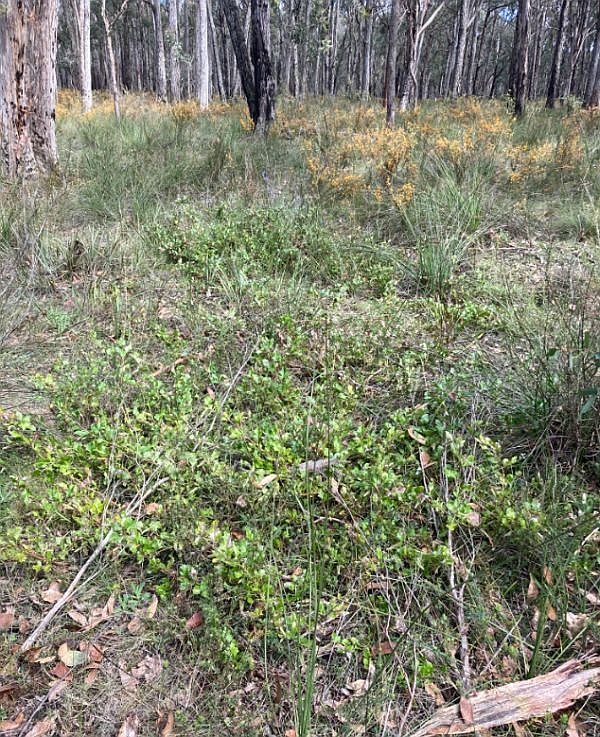
The Enfield Grevillea is a low growing plant from 0.2 to 1 m high and spreads to 3 m wide. It has bright green leaves which tend to stand out against the forest floor. Image: Irena Cassettari.
Distribution
The Enfield Grevillea has a very limited distribution across Victoria, only being found in a small area of reserved forested land in the Enfield State Park, Ross Creek State Forest and Linton/Nawnight-widwid State Forest about 30 km south of Ballarat.
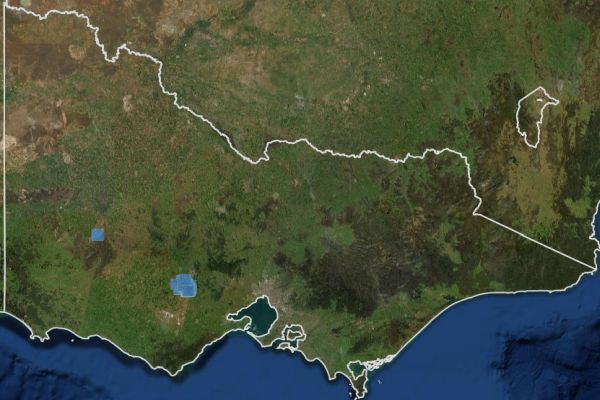
All known records of Enfield Grevillea. Note: record in Grampians is not verified. Source: VVB 2023.
The key local Government Area is Golden Plains Shire, although the species is only recorded in reserved forest there is a possibility it could occur on private remnant bushland or roadsides in the vicinity.
Ecology & Habitat
The Enfield Grevillea is found in grassy heathy dry forest type. It has been mostly recorded on roadsides within the forest but this may not be a true reflection of the species preferred habitat. Away from roadsides it has been found on ridgelines with a north-eastern aspect. More research is needed to better understand the plant ecology.
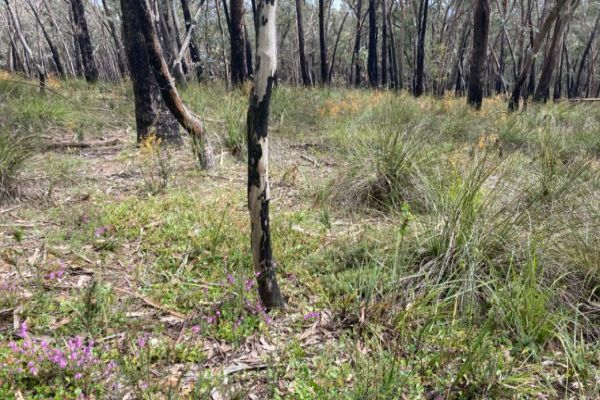
Image of Enfield Grevillea (lighter green foliage) growing on a dry ridgeline. Image: Irena Cassettari.
Flowering
Flowering occurs from October to November. The colour of the flowers can vary according to their maturity and position on the plant. As the flowers mature, they change from green to more of a red colour. Flowers at the top of the plant tend to mature before the lower flowers.
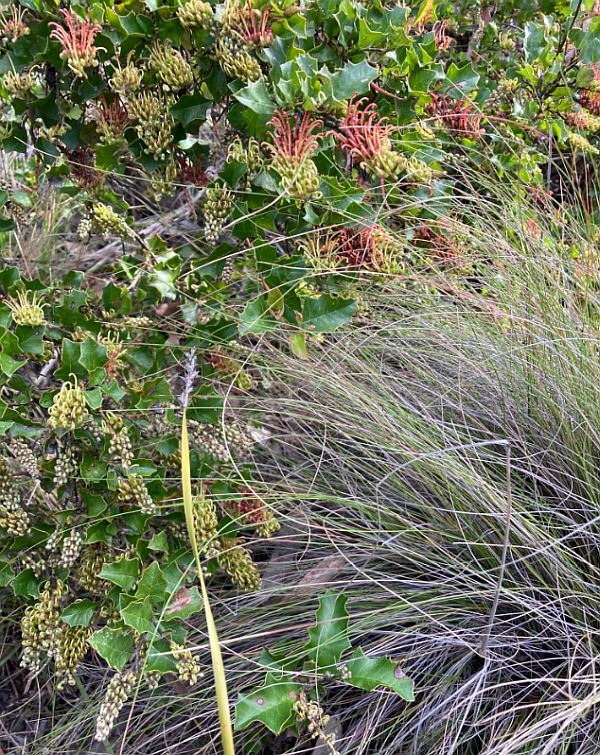
Flowers towards the top of the plant tend to mature faster and have more of a red colouration than green immature flowers. Image: Irena Cassettari.
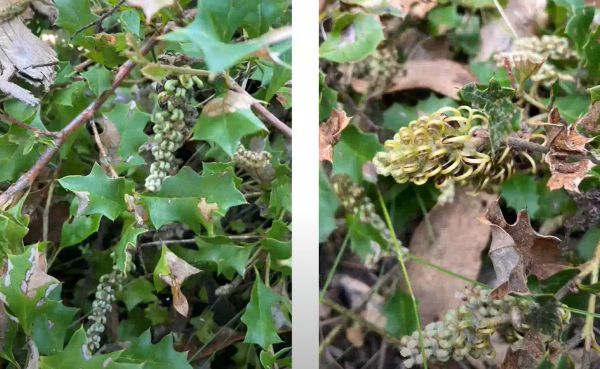
Development of green immature flower (left), development of a typical grevillea flower form (right).
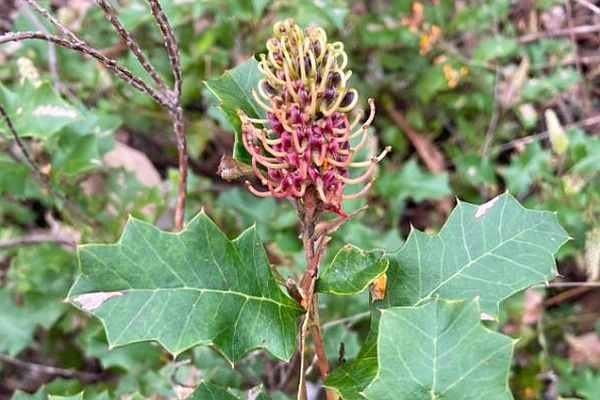
Fully developed Enfield Grevillea flower. Image: Irena Cassettari.
Roots can extend underground and emerge as new plant which are genetically identical. It is not known how many seeds are produced from flowers and the ideal conditions for germination.
Population Status
There are estimated to be 60 populations of Enfield grevillea containing over 37, 000 plants. Important populations are recognised as those with 1000 plants or more that occur in conservation reserves. This amounts to 11 populations with about 20, 000 individuals, or 52% of all known individuals, all of which occur in Enfield State Park (Carter et al., 2006).
The Enfield Grevillea is considered Endangered due to its restricted range and vulnerability to impacts which could wipe out an entire population.
Threats
More research is required to fully understand the range of threats to this species. The very limited geographic distribution of Enfield Grevillea poses a threat in itself as populations become more vulnerable due to changes in the landscape and climate change, particularly the frequency and severity of dry conditions which increases fire hazard.
The impact of fire is currently being studied through the Enfield Grevillea Fire Response Project.
Excessively frequent and hot burns may be harmful to established plants and the success of reproduction.
Weed invasion, particularly from soil disturbance poses a risk.
Conservation & Management
Conservation of the Enfield Grevillea is being managed by the Department of Energy, Environment and Climate Action (DEECA) Victoria, through forest management ensuring known populations are protected from harmful disturbance. Management includes pest plant and animal control along with ecological burning safeguards and monitoring.
Research
Enfield Grevillea Fire Response Project
This is a key project to improve knowledge about the species requirements and ensure its on-going survival. The project is implemented through the;
Grampians Bushfire Management Strategy 2020
- One of the long-term objectives: Persistence of rare, threatened and endemic species
- Sort-term objective; Minimise Impacts of planned burning on threatened species e.g., Enfield Grevillea. Put in place mitigation measures.
One of the key activities is to monitor plots established in a planned burn area to mprove understanding of plant response after burning.
Reproduction and genetic structure in the endangered Enfield Grevillea
This project consisted of two studies:
- assessment of floral characters, floral visitors and the impact that vertebrate and invertebrate visitors had on seed production in the species
- controlled pollination to document the potential and realised breeding system, as well as undertaking an analysis of genetic diversity and structure among selected populations.
The Enfield Grevillea was visited by birds, mammals and numerous insects but their contributions were not equal. The species was shown to be preferentially outcrossing and there was no evidence of pollination limitation. Populations of the species were genetically diverse and differentiation among some but not all populations was found.
The research was conducted primarily by two honours students (Mr A. Aristidou and Mr S. Wawrzyczek) with some additional sampling and analysis post-honours. Supervised by Dr Susan Hoebee, La Trobe University.
Projects & Partnerships
The main focus of management is through the Enfield Grevillea Fire Response Project managed by DEEAC. Community interest involves the Environmental Volunteers & Agency Network (Central West) and Napoleons Enfield Landcare Group.
Pre- and post-burn monitoring project. This is a long-term monitoring project to improve the understanding of fire intervals needed for the species to reproduce and persist. More details: ARI Research.
References & Links
Carter, O., Murphy, A.H. & Downe, J. (2006). National recovery plan for the Enfield grevillea Grevillea bedggoodiana. Department of Sustainability and Environment, Melbourne.
FFG Threatened List (2025) Flora and Fauna Guarantee Act 1988 - Threatened List - March 2025 Department of Energy, Environment and Climate Action (DEECA).
More Information
Flora of Victoria - Enfield Grevillea
Species profile and threats database - Enfield Grevillea, Department of Climate Change, Energy, Environment and Water, Australia
Enfield Grevillea Conservation Advice – EPBC Act Threatened Species Scientific Committee 2016 pdf
Victoria’s threatened Grevillea’s
Recording of presentation on Enfield Grevillea Fire Response Project - Environmental Volunteers & Agency Network (Central West)
Environmental Volunteers & Agency Network (Central West)
Enfield Grevillea optimal fire regimes: pre- and post-burn monitoring - ARI Fact Sheet -

